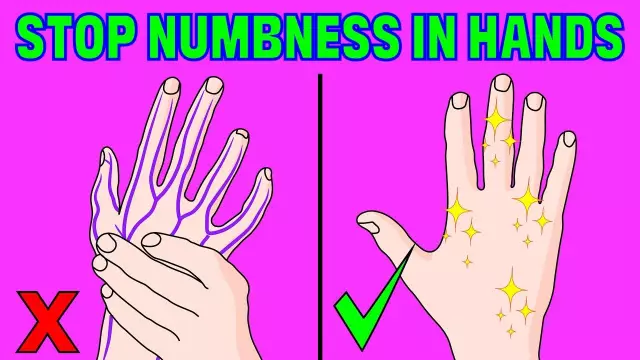- Author Rachel Wainwright [email protected].
- Public 2023-12-15 07:39.
- Last modified 2025-11-02 20:14.
A symptom of what disease can be numbness of the head
The causes of numbness in the head are not always associated with any medical condition. Hypesthesia of the head and any other parts of the body is considered the norm in cases when a person does not move for a long time or is in an uncomfortable position. This happens, for example, when the workplace is improperly equipped or during sleep. In such situations, blood circulation is temporarily interrupted, which leads to numbness and tingling sensations in the muscles and skin. After changing the position of the body, hypesthesia disappears on its own within a few minutes. It is possible to speed up the restoration of normal blood supply with the help of light massage.
Causes of numbness in the head
The danger is the frequent numbness of the head or neck, accompanied by such clinical signs as blurred vision and hearing, and fever. In particular, a consultation with a neurologist and a comprehensive examination are urgently required for the following symptoms:
- Violation of motor activity;
- Dizziness, unsteadiness of gait, general weakness;
- Involuntary emptying of your bowel or bladder;
- Slurred speech.
Concomitant symptoms are not able to reliably indicate the causes of head numbness, therefore, an accurate diagnosis is necessary.
Numbness combined with double vision, impaired coordination and general weakness can be caused by the following conditions and diseases:
- Injuries;
- Pinched nerves;
- Multiple sclerosis;
- Impaired blood circulation in the brain;
- Brain tumor.
Traumatic brain injury can lead to hemorrhage in the brain tissue or its membranes and require immediate hospitalization. The most dangerous are fractures of the cheekbone, upper jaw and eye sockets. In addition, a concussion can occur as a result of severe injury. Its symptoms usually subside within a few days. If this does not happen, then more serious brain damage was missed in the diagnosis. The problem that causes numbness in a part of the head can also be localized in the cervical spine, which also suffers from skull injuries.
Hypesthesia sometimes indicates a pinched ocular, maxillary, mandibular, or trigeminal nerve. Compression can occur as a result of tumors, post-traumatic adhesions, dilation of the cerebellar arteries, and inflammation of the sinuses and mouth. Neuralgia causes severe pain in the nose, eyes, and ears and is often accompanied by tingling or numbness of the head and face.
Bell's palsy is also a neurological damage. Despite the fact that it is considered a consequence of infection and inflammation of the facial nerve, the pathogenesis of paralysis is not fully understood. As a rule, its sudden onset is preceded by pain behind the ears and loss of taste. Recovery occurs within a few months. Paralysis and numbness of a part of the head only on the right or left side is considered a favorable prognostic sign.
In multiple sclerosis, certain areas of the nervous tissue are replaced by connective tissue cells. Loss of sensitivity, deterioration of vision and uncoordinated movements are observed. Hypoesthesia is caused by damage to the myelin sheath in the spinothalamic tract, which is responsible for transmitting signals about external stimuli (touch, temperature, pain, and others).
A transient violation of cerebral circulation is paroxysmal in nature and most often appears as a complication of atherosclerosis, hypertension, or osteochondrosis. Focal symptoms differ depending on the location of the pathology. The head becomes numb only with PNMC in the internal carotid artery system. Numbness of a part of the head almost always occurs on the side where blood circulation is impaired, and hypesthesia on the opposite side is quite rare. Other symptoms include a deep decrease in sensitivity in half of the upper lip and tongue, sometimes sudden blindness in one eye. Regardless of the sensitivity disorder, there is a limitation of mobility, often in combination with dysarthria or aphasia. If focal symptoms are observed for more than a day, then such violations should be perceived as a cerebral stroke. Timely initiation of therapy (in the first 6-12 hours) allows to limit the affected area and restore the lost brain functions.
Any brain tumor as it develops causes numbness in the head due to the limited volume of the skull. The growth of the neoplasm leads to pressure on the surrounding areas of the brain, disrupting their functioning, therefore, visual impairment, weakness and headaches can be observed.
Head numbness can also occur for a number of other reasons that do not directly threaten a person's life, but can cause pain and other unpleasant sensations. Among the factors provoking hypesthesia, it should be noted incorrectly performed dental procedures, shingles in the face, as well as vitamin deficiency.
Diagnostics and treatment of diseases with head numbness
With regular numbness of the scalp and neck, it is necessary to urgently consult a neurologist, especially if the duration of the attacks exceeds 2-3 minutes.
Diagnostics should include the following methods:
- A complete blood count can detect iron deficiency anemia, as well as Addison-Birmer disease, in which hematopoiesis is impaired due to a lack of vitamin B12;
- X-rays and magnetic resonance imaging determine bone misalignment and other pathologies that could result in nerve damage and head numbness;
- Electroneuromyography establishes the location of the affected nerve, and also reveals neuropathy and carpal syndrome;
- Doppler ultrasound diagnoses diseases of the vascular system and circulatory disorders in the carotid or vertebro-basilar artery.
Other studies and tests may also be needed depending on the internal and clinical presentation of head numbness. A history of craniocerebral trauma requires consultation with a surgeon and traumatologist. If there is numbness in the chin area after orthodontic manipulations, consult a dentist. In case of lesions of internal organs, a multidisciplinary examination is necessary.
The choice of treatment method directly depends on the root causes of head numbness and should be carried out only after comprehensive studies of the body. Full rehabilitation sometimes takes place for a long time, but it is necessary to complete the treatment in order to avoid various complications that can be life-threatening.
During hypesthesia, care should be taken near heat sources and while eating, as due to a violation of sensitivity, you can accidentally injure the oral cavity or get burned. In addition, it is recommended to avoid situations in which head numbness occurs most often, since the intensity of this symptom may depend on external factors.
YouTube video related to the article:
Found a mistake in the text? Select it and press Ctrl + Enter.






